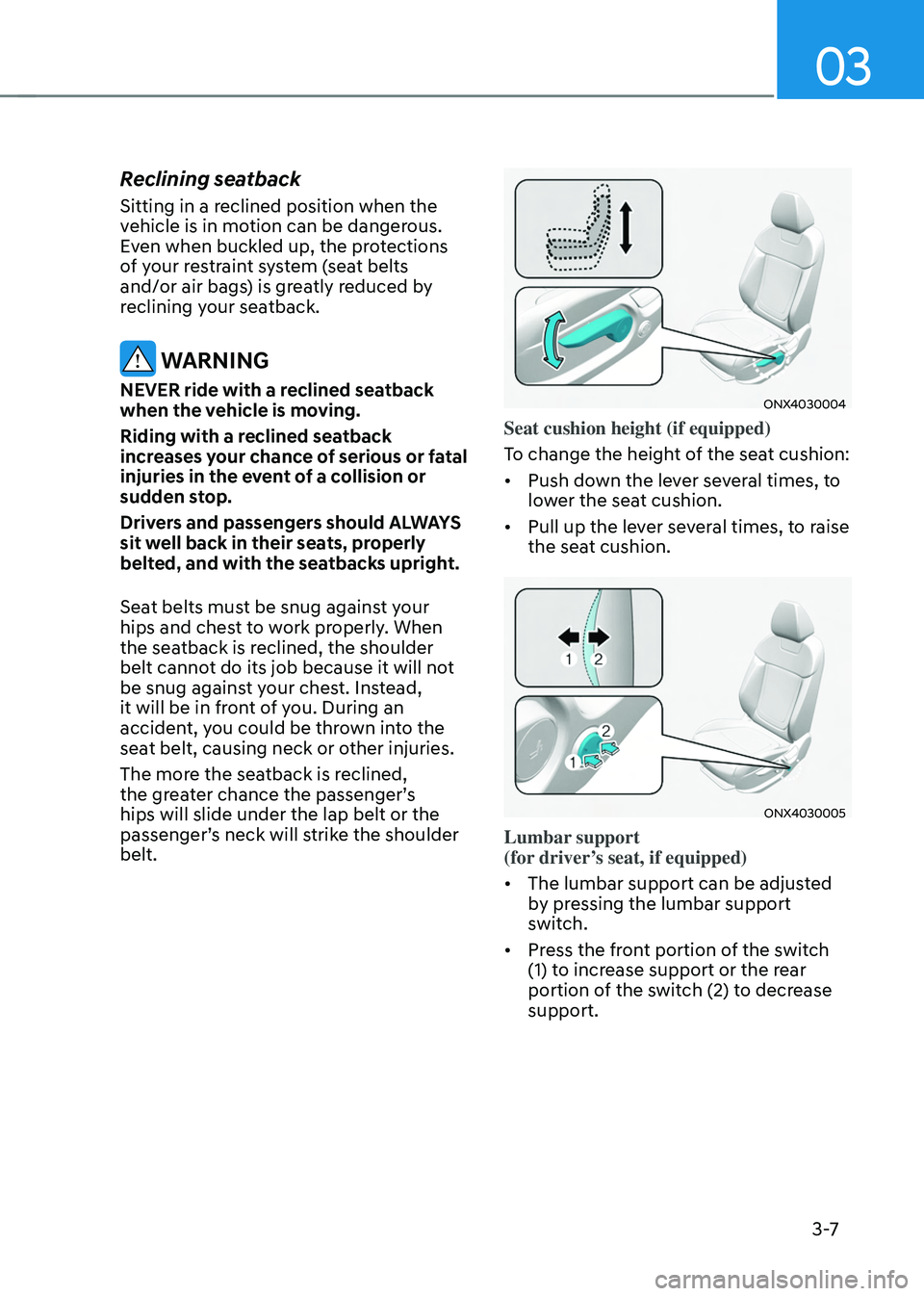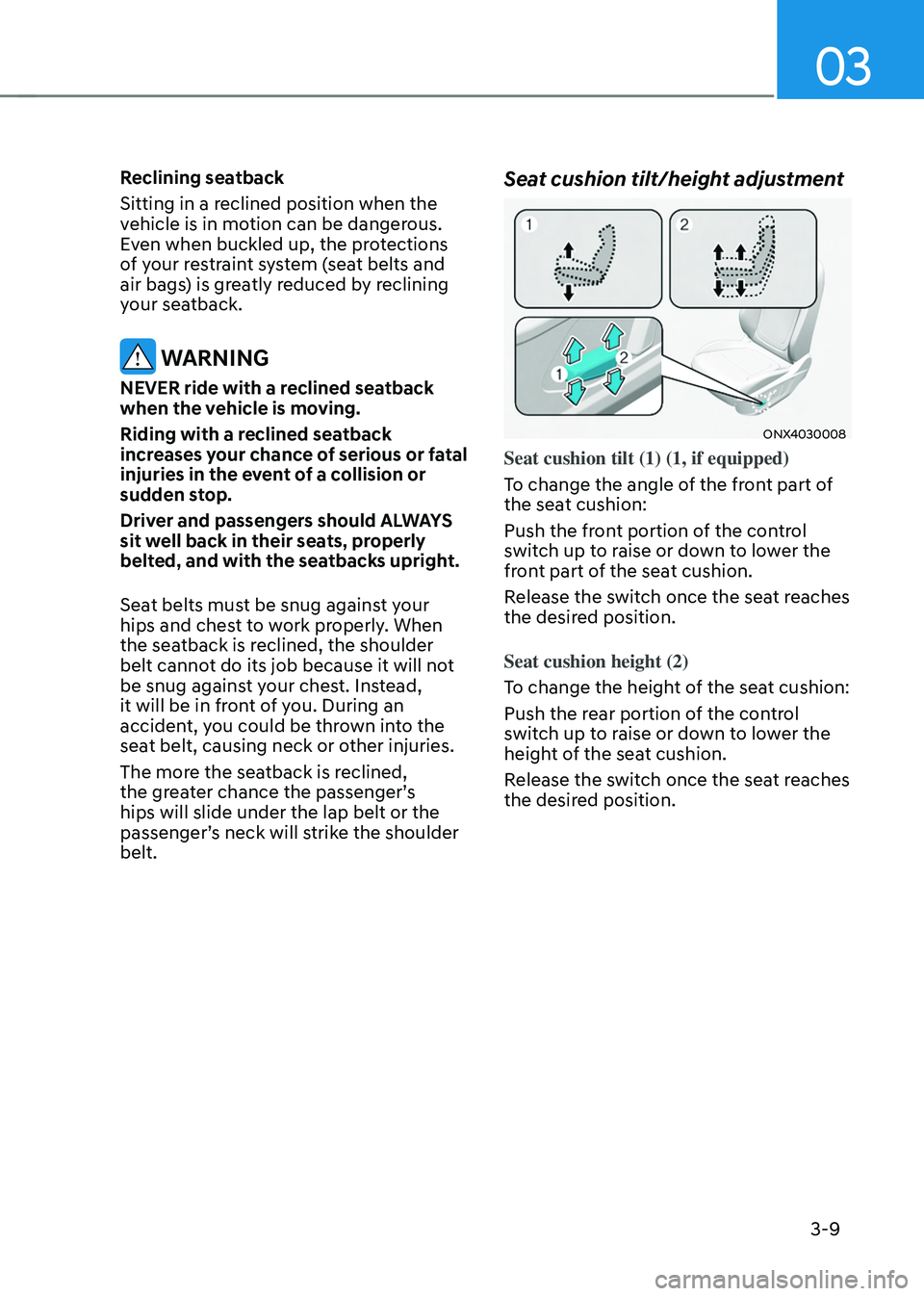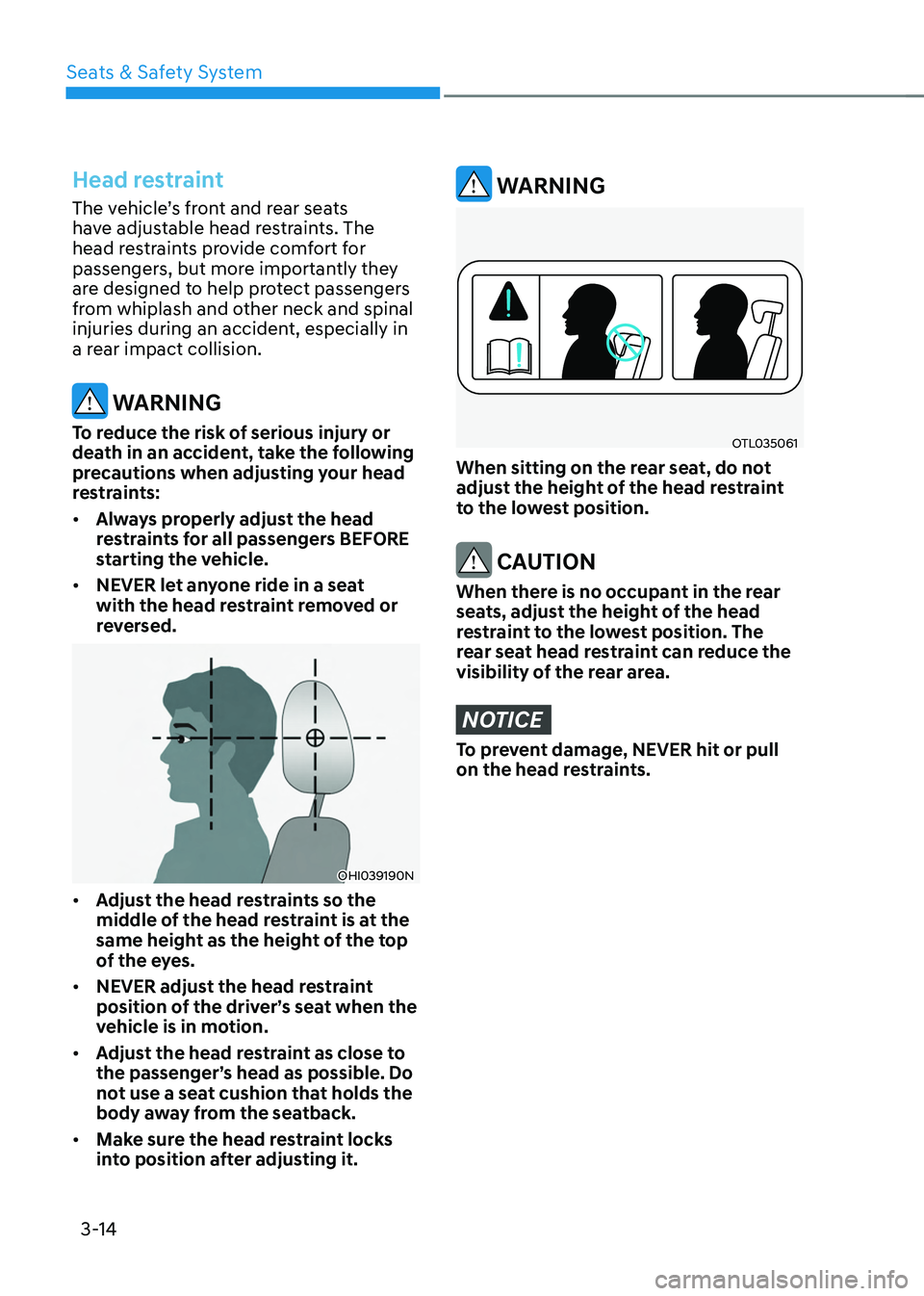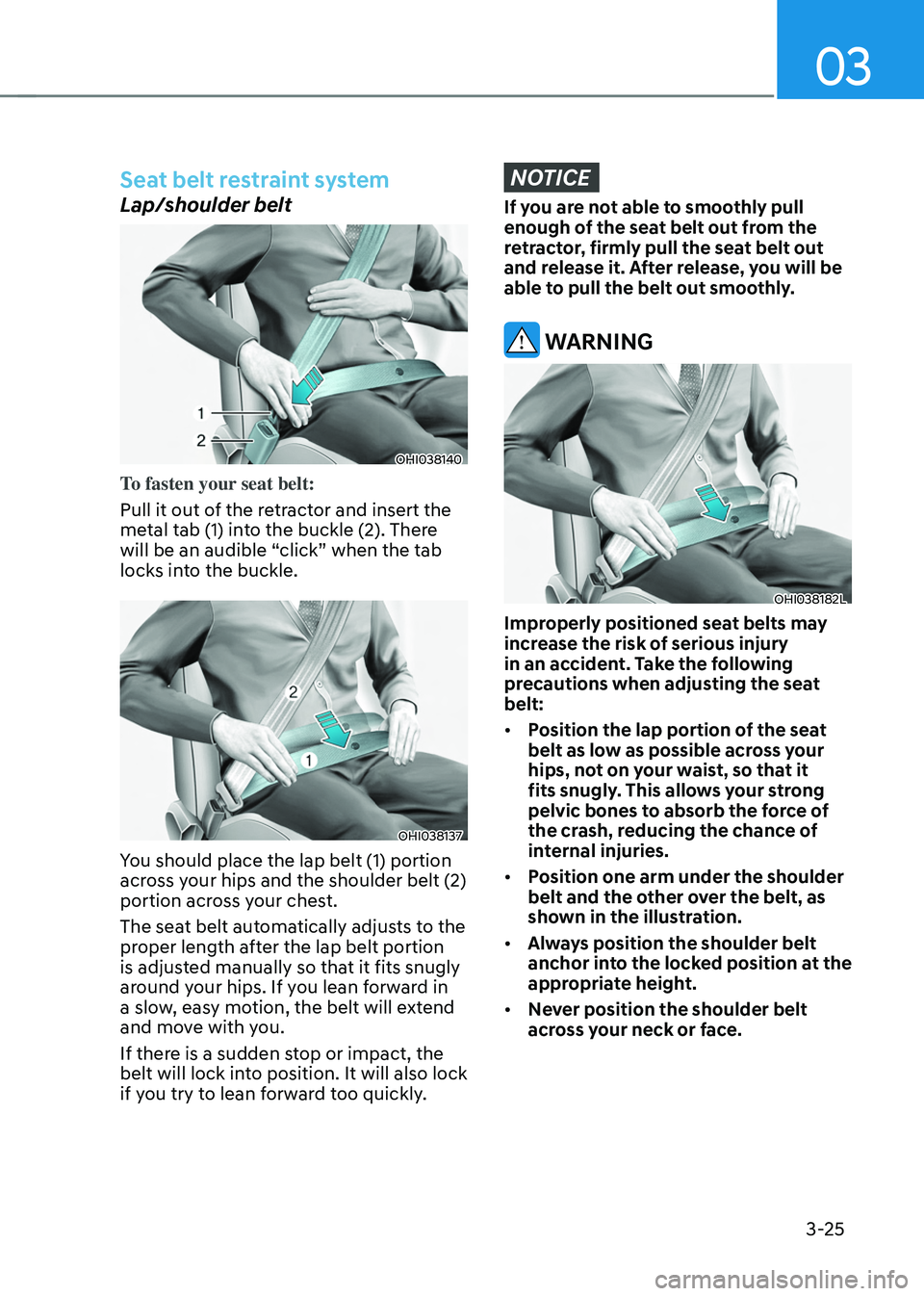Page 37 of 630
Vehicle Information, Consumer Information and Reporting Safety Defects
2-8
Itemsin. (mm)
Overall length 182.3 (4,630)
Overall width 73.4 (1,865)
Overall height 65.55 (1,665) / 66.34 (1,685)*
Wheel tread Front
Rear
235/65 R17 63.8 (1,620) 64.05 (1,627)
235/55 R19 63.58 (1,615) 63.9 (1,622)
Wheelbase 108.5(2,755)
* : 4WD
ENGINE
EngineDisplacement
cu. in (cc) Bore x Stroke
in. (mm) Firing order
No. of cylinders
Smartstream G 1.6 T-GDi HEV 97.51 (1,598) 2.97 x 3.5
(75.6 x 89.0) 1-3-4-2
In-line 4 cylinder
DIMENSIONS
Page 53 of 630

03
3 -7
Reclining seatback
Sitting in a reclined position when the
vehicle is in motion can be dangerous.
Even when buckled up, the protections
of your restraint system (seat belts
and/or air bags) is greatly reduced by
reclining your seatback.
WARNING
NEVER ride with a reclined seatback
when the vehicle is moving.
Riding with a reclined seatback
increases your chance of serious or fatal
injuries in the event of a collision or
sudden stop.
Drivers and passengers should ALWAYS
sit well back in their seats, properly
belted, and with the seatbacks upright.
Seat belts must be snug against your
hips and chest to work properly. When
the seatback is reclined, the shoulder
belt cannot do its job because it will not
be snug against your chest. Instead,
it will be in front of you. During an
accident, you could be thrown into the
seat belt, causing neck or other injuries.
The more the seatback is reclined,
the greater chance the passenger’s
hips will slide under the lap belt or the
passenger’s neck will strike the shoulder
belt.ONX4030004
Seat cushion height (if equipped)
To change the height of the seat cushion:
• Push down the lever several times, to
lower the seat cushion.
• Pull up the lever several times, to raise
the seat cushion.
ONX4030005
Lumbar support
(for driver’s seat, if equipped)
• The lumbar support can be adjusted
by pressing the lumbar support
switch.
• Press the front portion of the switch
(1) to increase support or the rear
portion of the switch (2) to decrease
support.
Page 55 of 630

03
3-9
Reclining seatback
Sitting in a reclined position when the
vehicle is in motion can be dangerous.
Even when buckled up, the protections
of your restraint system (seat belts and
air bags) is greatly reduced by reclining
your seatback.
WARNING
NEVER ride with a reclined seatback
when the vehicle is moving.
Riding with a reclined seatback
increases your chance of serious or fatal
injuries in the event of a collision or
sudden stop.
Driver and passengers should ALWAYS
sit well back in their seats, properly
belted, and with the seatbacks upright.
Seat belts must be snug against your
hips and chest to work properly. When
the seatback is reclined, the shoulder
belt cannot do its job because it will not
be snug against your chest. Instead,
it will be in front of you. During an
accident, you could be thrown into the
seat belt, causing neck or other injuries.
The more the seatback is reclined,
the greater chance the passenger’s
hips will slide under the lap belt or the
passenger’s neck will strike the shoulder
belt.
Seat cushion tilt/height adjustment
ONX4030008
Seat cushion tilt (1) (1, if equipped)
To change the angle of the front part of
the seat cushion:
Push the front portion of the control
switch up to raise or down to lower the
front part of the seat cushion.
Release the switch once the seat reaches
the desired position.
Seat cushion height (2)
To change the height of the seat cushion:
Push the rear portion of the control
switch up to raise or down to lower the
height of the seat cushion.
Release the switch once the seat reaches
the desired position.
Page 60 of 630

Seats & Safety System
3-14
Head restraint
The vehicle’s front and rear seats
have adjustable head restraints. The
head restraints provide comfort for
passengers, but more importantly they
are designed to help protect passengers
from whiplash and other neck and spinal
injuries during an accident, especially in
a rear impact collision.
WARNING
To reduce the risk of serious injury or
death in an accident, take the following
precautions when adjusting your head
restraints:
• Always properly adjust the head
restraints for all passengers BEFORE
starting the vehicle.
• NEVER let anyone ride in a seat
with the head restraint removed or
reversed.
OHI039190N
• Adjust the head restraints so the
middle of the head restraint is at the
same height as the height of the top
of the eyes.
• NEVER adjust the head restraint
position of the driver’s seat when the
vehicle is in motion.
• Adjust the head restraint as close to
the passenger’s head as possible. Do
not use a seat cushion that holds the
body away from the seatback.
• Make sure the head restraint locks
into position after adjusting it.
WARNING
OTL035061
When sitting on the rear seat, do not
adjust the height of the head restraint
to the lowest position.
CAUTION
When there is no occupant in the rear
seats, adjust the height of the head
restraint to the lowest position. The
rear seat head restraint can reduce the
visibility of the rear area.
NOTICE
To prevent damage, NEVER hit or pull
on the head restraints.
Page 61 of 630
03
3-15
Front seat head restraints
ONX4E030035
The driver’s and front passenger’s seats
are equipped with adjustable head
restraints for the passengers safety and
comfort.
ONX4030011
Adjusting the height up and down
To raise the head restraint:
1.
Pull it up to the desir
ed position (1).
To lower the head restraint:
1.
Push and hold the release butt
on (2)
on the head restraint support.
2.
Lo
wer the head restraint to the
desired position (3).
NOTICE
OHI038136
If you recline the seatback towards the
front with the head restraint and seat
cushion raised, the head restraint may
come in contact with the sunvisor or
other parts of the vehicle.
Page 62 of 630
Seats & Safety System
3-16
„„Type A
ONX4030012
„„Type B
ONX4030013
Removal/Reinstall
To remove the head restraint:
1.
Recline the sea
tback (2) with using
the seatback angle knob or switch (1).
2.
Raise the head res
traint as far as it can
go.
3.
Press the head r
estraint release button
(3) while pulling the head restraint up
(4).
WARNING
NEVER allow anyone to travel in a seat
with the head restraint removed.
„„Type A
ONX4030014
„„Type B
ONX4030015
To reinstall the head restraint :
1.
Recline the sea
tback.
2.
Put the head res
traint poles (2) into
the holes while pressing the release
button (1).
3.
Adjus
t the head restraint to the
appropriate height.
4.
Recline the sea
tback (4) with the
seatback angle knob or switch (3).
WARNING
Always make sure the head restraint
locks into position after reinstalling and
adjusting it properly.
Page 63 of 630
03
3-17
Rear seat head restraints
ONX4E030061
The rear seats are equipped with head
restraints in all the seating positions for
the passenger’s safety and comfort.
ONX4030020
Adjusting the height up and down
To raise the head restraint:
1.
Pull it up to the desir
ed position (1).
To lower the head restraint:
1.
Push and hold the release butt
on (2)
on the head restraint support.
2.
Lo
wer the head restraint to the
desired position (3).
ONX4030016
Removal/Reinstallation
To remove the head restraint:
1.
Raise the head res
traint as far as it can
go.
2.
Press the head r
estraint release button
(1) while pulling the head restraint up
(2).
To reinstall the head restraint:
1.
Put the head res
traint poles into the
holes (3) while pressing the release
button (1).
2.
Adjus
t the head restraint to the
appropriate height.
Page 71 of 630

03
3-25
Seat belt restraint system
Lap/shoulder belt
OHI038140
To fasten your seat belt:
Pull it out of the retractor and insert the
metal tab (1) into the buckle (2). There
will be an audible “click” when the tab
locks into the buckle.
OHI038137
You should place the lap belt (1) portion
across your hips and the shoulder belt (2)
portion across your chest.
The seat belt automatically adjusts to the
proper length after the lap belt portion
is adjusted manually so that it fits snugly
around your hips. If you lean forward in
a slow, easy motion, the belt will extend
and move with you.
If there is a sudden stop or impact, the
belt will lock into position. It will also lock
if you try to lean forward too quickly.
NOTICE
If you are not able to smoothly pull
enough of the seat belt out from the
retractor, firmly pull the seat belt out
and release it. After release, you will be
able to pull the belt out smoothly.
WARNING
OHI038182L
Improperly positioned seat belts may
increase the risk of serious injury
in an accident. Take the following
precautions when adjusting the seat
belt:
• Position the lap portion of the seat
belt as low as possible across your
hips, not on your waist, so that it
fits snugly. This allows your strong
pelvic bones to absorb the force of
the crash, reducing the chance of
internal injuries.
• Position one arm under the shoulder
belt and the other over the belt, as
shown in the illustration.
• Always position the shoulder belt
anchor into the locked position at the
appropriate height.
• Never position the shoulder belt
across your neck or face.